MITSUBISHI CARISMA 2000 1.G Owners Manual
Manufacturer: MITSUBISHI, Model Year: 2000, Model line: CARISMA, Model: MITSUBISHI CARISMA 2000 1.GPages: 280, PDF Size: 2.32 MB
Page 101 of 280
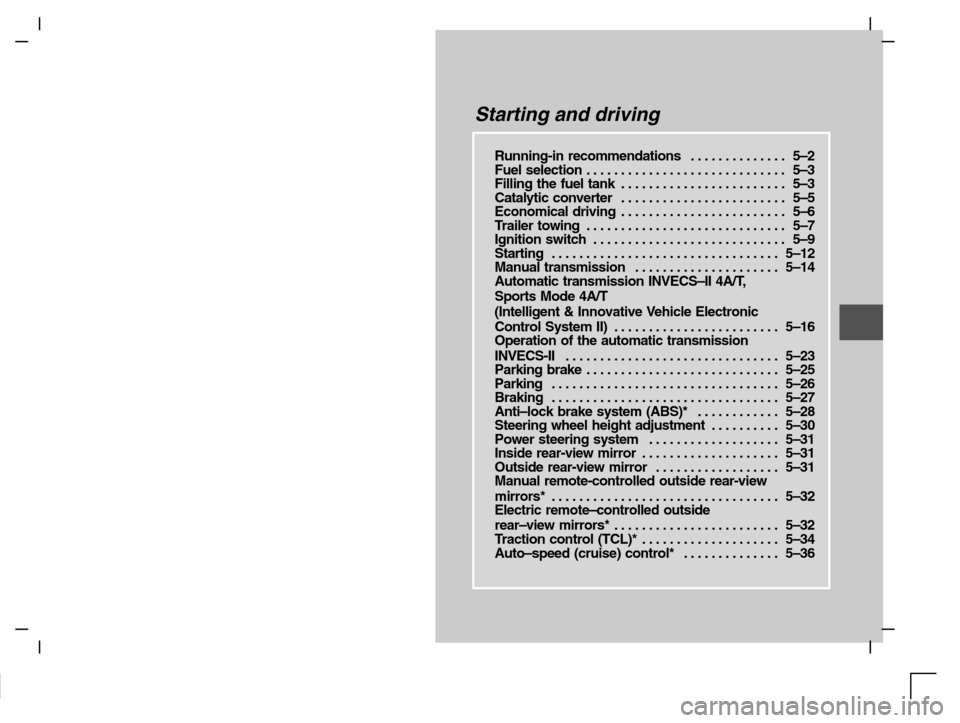
Starting and driving
Running-in recommendations 5–2. . . . . . . . . . . . . .
Fuel selection 5–3. . . . . . . . . . . . . . . . . . . . . . . . . . . . .
Filling the fuel tank 5–3. . . . . . . . . . . . . . . . . . . . . . . .
Catalytic converter 5–5. . . . . . . . . . . . . . . . . . . . . . . .
Economical driving 5–6. . . . . . . . . . . . . . . . . . . . . . . .
Tr ailer towing 5–7. . . . . . . . . . . . . . . . . . . . . . . . . . . . .
Ignition switch 5–9. . . . . . . . . . . . . . . . . . . . . . . . . . . .
Starting 5–12. . . . . . . . . . . . . . . . . . . . . . . . . . . . . . . . .
Manual transmission 5–14. . . . . . . . . . . . . . . . . . . . .
Automatic transmission INVECS–II 4A/T,
Sports Mode 4A/T
(Intelligent & Innovative Vehicle Electronic
Control System II) 5–16. . . . . . . . . . . . . . . . . . . . . . . .
Operation of the automatic transmission
INVECS-II 5–23. . . . . . . . . . . . . . . . . . . . . . . . . . . . . . .
Parking brake 5–25. . . . . . . . . . . . . . . . . . . . . . . . . . . .
Parking 5–26. . . . . . . . . . . . . . . . . . . . . . . . . . . . . . . . .
Braking 5–27. . . . . . . . . . . . . . . . . . . . . . . . . . . . . . . . .
Anti–lock brake system (ABS)* 5–28. . . . . . . . . . . .
Steering wheel height adjustment 5–30. . . . . . . . . .
Power steering system 5–31. . . . . . . . . . . . . . . . . . .
Inside rear-view mirror 5–31. . . . . . . . . . . . . . . . . . . .
Outside rear-view mirror 5–31. . . . . . . . . . . . . . . . . .
Manual remote-controlled outside rear-view
mirrors* 5–32. . . . . . . . . . . . . . . . . . . . . . . . . . . . . . . . .
Electric remote–controlled outside
rear–view mirrors* 5–32. . . . . . . . . . . . . . . . . . . . . . . .
Traction control (TCL)* 5–34. . . . . . . . . . . . . . . . . . . .
Auto–speed (cruise) control* 5–36. . . . . . . . . . . . . .
Page 102 of 280

STARTING AND DRIVING
5–2
Running-in
recommendations
EA01AMKi
During the running-in period for the first
1,000 km, it is advisable to drive your new
vehicle using the following precautions as a
guideline to aid long life as well as future
economy and performance.
(1) Do not race the engine at high speeds.
(2) Avoid rapid starting, accelerating, brak-
ing and prolonged high-speed running.
(3) Keep to the running-in speed limit
shown below.
Please note that the legal speed limits
displayed must be adhered to.
(4) Do not exceed loading limits.
(5) Refrain from towing a trailer.
Ve h i c les with manual transmissionkm/h
Speed limit
DrivePetrol-powered vehicleDiesel-range
130016001800
(GDI)powered
vehicle
1st25353025
2nd50606045
3rd80909070
4th105120120100
5th130150155135
Vehicles with automatic trans-
mission INVECS-II 4A/T
km/h
Drive rangeSpeed limitDrive range1600
“L” (LOW)30
“2” (SECOND)70
“3” (THIRD)105
“D” (DRIVE)120
Ve h i c les with automatic trans-
mission INVECS-II
Sport Mode 4A/T
km/h
Drive rangeSpeed limit
1st30
2nd80
3rd120
4th130
Page 103 of 280
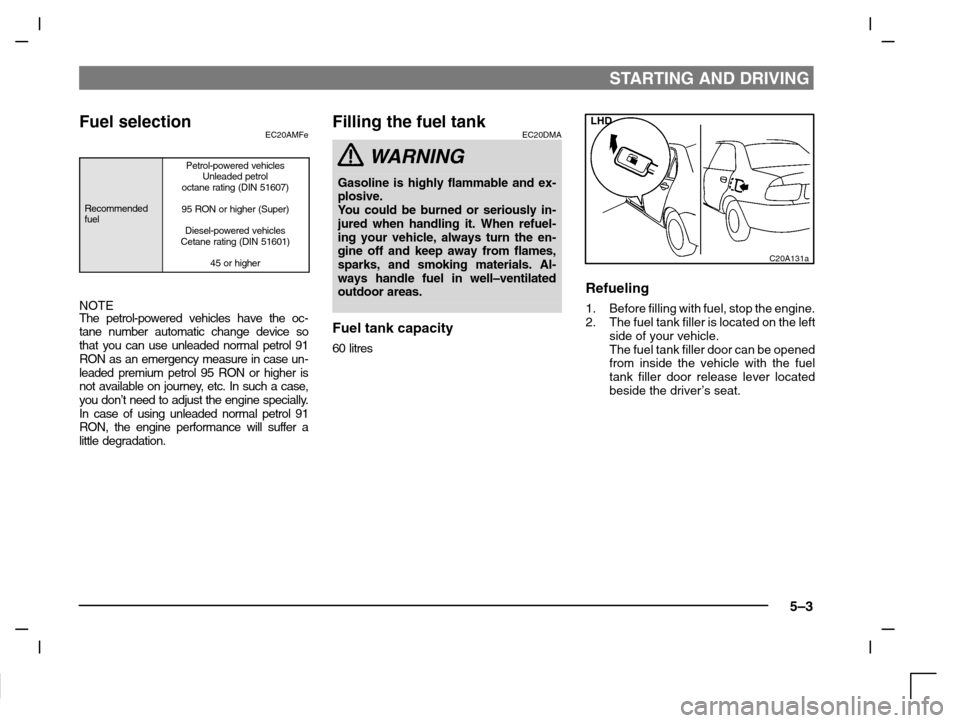
STARTING AND DRIVING
5–3
Fuel selectionEC20AMFe
Recommended
fuel
Petrol-powered vehicles
Unleaded petrol
octane rating (DIN 51607)
95 RON or higher (Super)
Diesel-powered vehicles
Cetane rating (DIN 51601)
45 or higher
NOTE
The petrol-powered vehicles have the oc-
tane number automatic change device so
that you can use unleaded normal petrol 91
RON as an emergency measure in case un-
leaded premium petrol 95 RON or higher is
not available on journey, etc. In such a case,
you don’t need to adjust the engine specially.
In case of using unleaded normal petrol 91
RON, the engine performance will suffer a
little degradation.
Filling the fuel tankEC20DMA
WARNING
Gasoline is highly flammable and ex-
plosive.
Yo u could be burned or seriously in-
jured when handling it. When refuel-
ing your vehicle, always turn the en-
gine off and keep away from flames,
sparks, and smoking materials. Al-
ways handle fuel in well–ventilated
outdoor areas.
Fuel tank capacity
60 litres
LHD
C20A131a
Refueling
1. Before filling with fuel, stop the engine.
2. The fuel tank filler is located on the left
side of your vehicle.
The fuel tank filler door can be opened
from inside the vehicle with the fuel
tank filler door release lever located
beside the driver’s seat.
Page 104 of 280
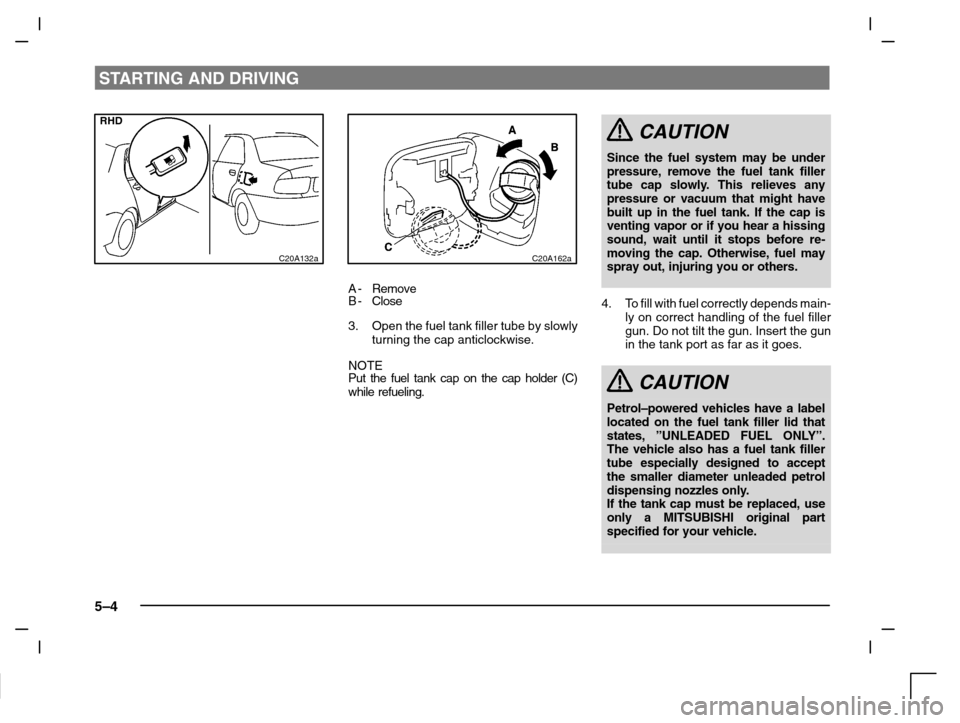
STARTING AND DRIVING
5–4
C20A132a
RHD
C20A162a
A- Remove
B- Close
3. Open the fuel tank filler tube by slowly
turning the cap anticlockwise.
NOTE
Put the fuel tank cap on the cap holder (C)
while refueling.
CAUTION
Since the fuel system may be under
pressure, remove the fuel tank filler
tube cap slowly. This relieves any
pressure or vacuum that might have
built up in the fuel tank. If the cap is
venting vapor or if you hear a hissing
sound, wait until it stops before re-
moving the cap. Otherwise, fuel may
spray out, injuring you or others.
4. To fill with fuel correctly depends main-
ly on correct handling of the fuel filler
gun. Do not tilt the gun. Insert the gun
in the tank port as far as it goes.
CAUTION
Petrol–powered vehicles have a label
located on the fuel tank filler lid that
states, ”UNLEADED FUEL ONLY”.
The vehicle also has a fuel tank filler
tube especially designed to accept
the smaller diameter unleaded petrol
dispensing nozzles only.
If the tank cap must be replaced, use
only a MITSUBISHI original part
specified for your vehicle.
Page 105 of 280
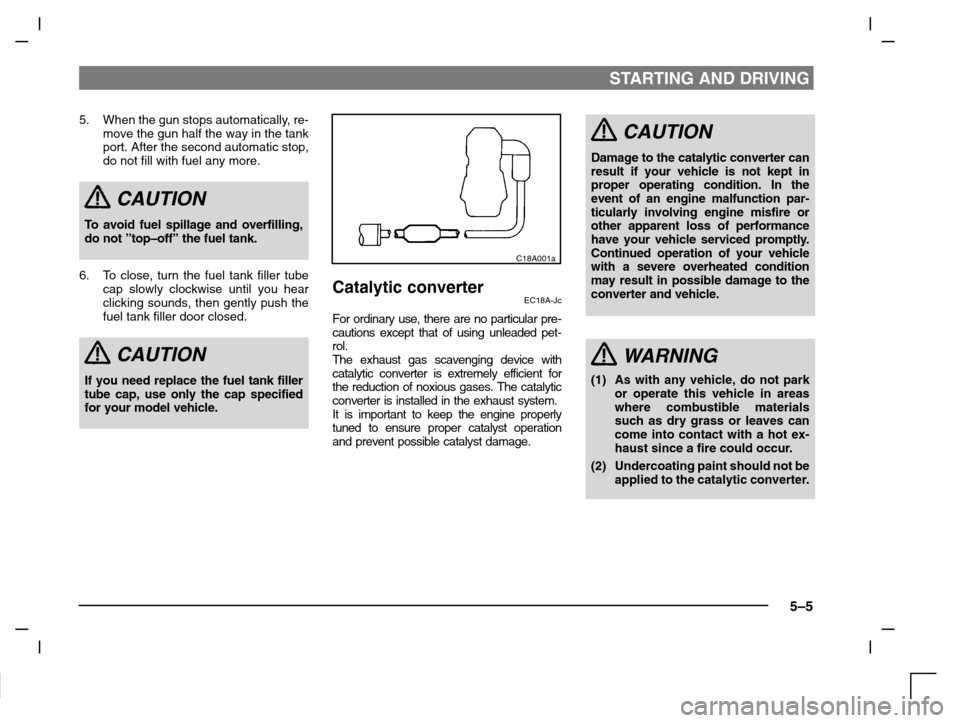
STARTING AND DRIVING
5–5
5. When the gun stops automatically, re-
move the gun half the way in the tank
port. After the second automatic stop,
do not fill with fuel any more.
CAUTION
To avoid fuel spillage and overfilling,
do not ”top–off” the fuel tank.
6. To close, turn the fuel tank filler tube
cap slowly clockwise until you hear
clicking sounds, then gently push the
fuel tank filler door closed.
CAUTION
If you need replace the fuel tank filler
tube cap, use only the cap specified
for your model vehicle.
C18A001a
Catalytic converterEC18A-Jc
For ordinary use, there are no particular pre-
cautions except that of using unleaded pet-
rol.
The exhaust gas scavenging device with
catalytic converter is extremely efficient for
the reduction of noxious gases. The catalytic
converter is installed in the exhaust system.
It is important to keep the engine properly
tuned to ensure proper catalyst operation
and prevent possible catalyst damage.
CAUTION
Damage to the catalytic converter can
result if your vehicle is not kept in
proper operating condition. In the
event of an engine malfunction par-
ticularly involving engine misfire or
other apparent loss of performance
have your vehicle serviced promptly.
Continued operation of your vehicle
with a severe overheated condition
may result in possible damage to the
converter and vehicle.
WARNING
(1) As with any vehicle, do not park
or operate this vehicle in areas
where combustible materials
such as dry grass or leaves can
come into contact with a hot ex-
haust since a fire could occur.
(2) Undercoating paint should not be
applied to the catalytic converter.
Page 106 of 280
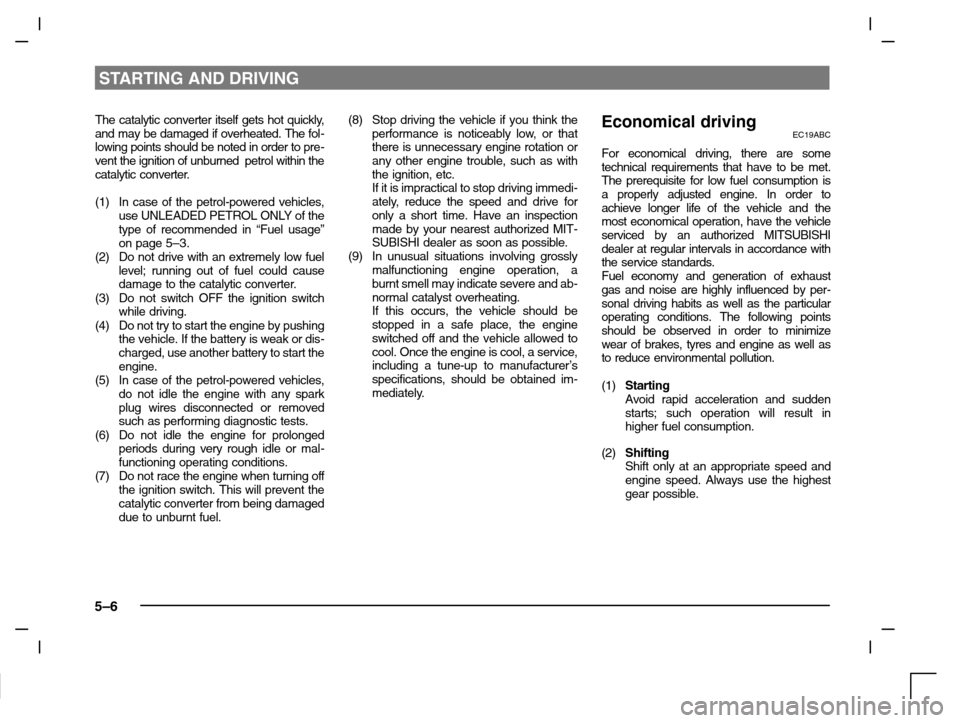
STARTING AND DRIVING
5–6
The catalytic converter itself gets hot quickly,
and may be damaged if overheated. The fol-
lowing points should be noted in order to pre-
vent the ignition of unburned petrol within the
catalytic converter.
(1) In case of the petrol-powered vehicles,
use UNLEADED PETROL ONLY of the
type of recommended in “Fuel usage”
on page 5–3.
(2) Do not drive with an extremely low fuel
level; running out of fuel could cause
damage to the catalytic converter.
(3) Do not switch OFF the ignition switch
while driving.
(4) Do not try to start the engine by pushing
the vehicle. If the battery is weak or dis-
charged, use another battery to start the
engine.
(5) In case of the petrol-powered vehicles,
do not idle the engine with any spark
plug wires disconnected or removed
such as performing diagnostic tests.
(6) Do not idle the engine for prolonged
periods during very rough idle or mal-
functioning operating conditions.
(7) Do not race the engine when turning off
the ignition switch. This will prevent the
catalytic converter from being damaged
due to unburnt fuel.(8) Stop driving the vehicle if you think the
performance is noticeably low, or that
there is unnecessary engine rotation or
any other engine trouble, such as with
the ignition, etc.
If it is impractical to stop driving immedi-
ately, reduce the speed and drive for
only a short time. Have an inspection
made by your nearest authorized MIT-
SUBISHI dealer as soon as possible.
(9) In unusual situations involving grossly
malfunctioning engine operation, a
burnt smell may indicate severe and ab-
normal catalyst overheating.
If this occurs, the vehicle should be
stopped in a safe place, the engine
switched off and the vehicle allowed to
cool. Once the engine is cool, a service,
including a tune-up to manufacturer’s
specifications, should be obtained im-
mediately.Economical drivingEC19ABC
For economical driving, there are some
technical requirements that have to be met.
The prerequisite for low fuel consumption is
a properly adjusted engine. In order to
achieve longer life of the vehicle and the
most economical operation, have the vehicle
serviced by an authorized MITSUBISHI
dealer at regular intervals in accordance with
the service standards.
Fuel economy and generation of exhaust
gas and noise are highly influenced by per-
sonal driving habits as well as the particular
operating conditions. The following points
should be observed in order to minimize
wear of brakes, tyres and engine as well as
to reduce environmental pollution.
(1)Starting
Avoid rapid acceleration and sudden
starts; such operation will result in
higher fuel consumption.
(2)Shifting
Shift only at an appropriate speed and
engine speed. Always use the highest
gear possible.
Page 107 of 280
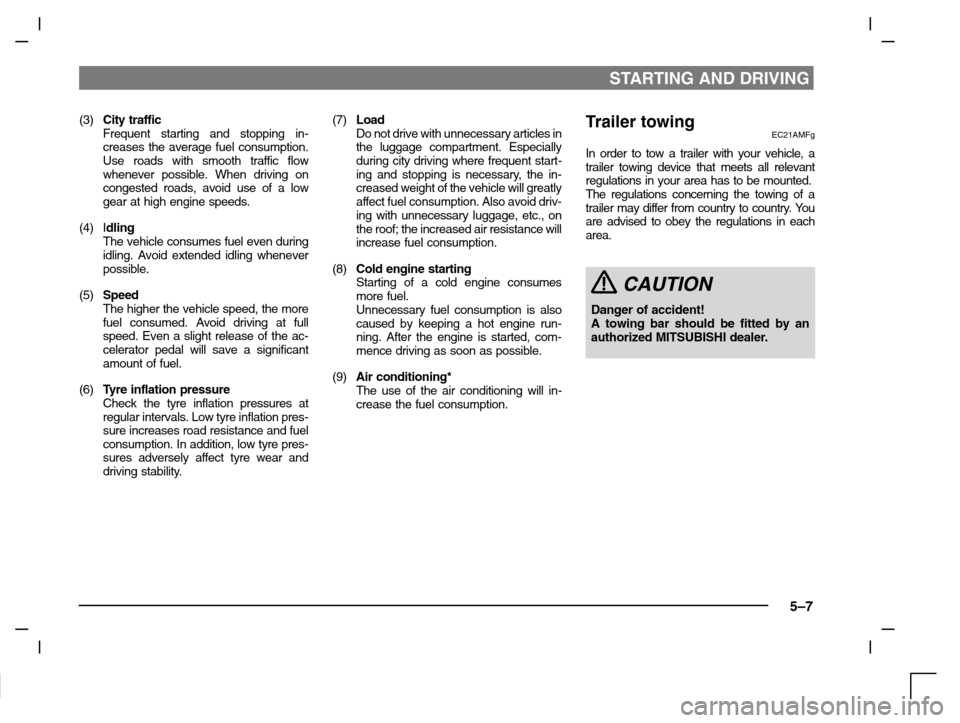
STARTING AND DRIVING
5–7
(3)City traffic
Frequent starting and stopping in-
creases the average fuel consumption.
Use roads with smooth traffic flow
whenever possible. When driving on
congested roads, avoid use of a low
gear at high engine speeds.
(4) Idling
The vehicle consumes fuel even during
idling. Avoid extended idling whenever
possible.
(5)Speed
The higher the vehicle speed, the more
fuel consumed. Avoid driving at full
speed. Even a slight release of the ac-
celerator pedal will save a significant
amount of fuel.
(6)Tyre inflation pressure
Check the tyre inflation pressures at
regular intervals. Low tyre inflation pres-
sure increases road resistance and fuel
consumption. In addition, low tyre pres-
sures adversely affect tyre wear and
driving stability.(7)Load
Do not drive with unnecessary articles in
the luggage compartment. Especially
during city driving where frequent start-
ing and stopping is necessary, the in-
creased weight of the vehicle will greatly
affect fuel consumption. Also avoid driv-
ing with unnecessary luggage, etc., on
the roof; the increased air resistance will
increase fuel consumption.
(8)Cold engine starting
Starting of a cold engine consumes
more fuel.
Unnecessary fuel consumption is also
caused by keeping a hot engine run-
ning. After the engine is started, com-
mence driving as soon as possible.
(9)Air conditioning*
The use of the air conditioning will in-
crease the fuel consumption.Trailer towingEC21AMFg
In order to tow a trailer with your vehicle, a
trailer towing device that meets all relevant
regulations in your area has to be mounted.
The regulations concerning the towing of a
trailer may differ from country to country. You
are advised to obey the regulations in each
area.
CAUTION
Danger of accident!
A towing bar should be fitted by an
authorized MITSUBISHI dealer.
Page 108 of 280
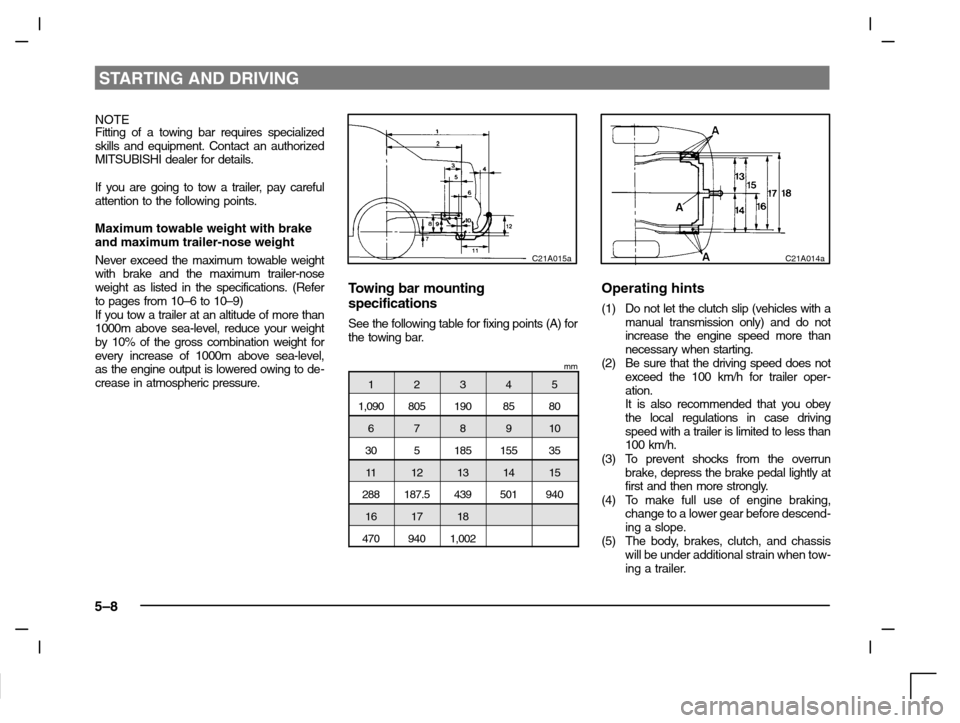
STARTING AND DRIVING
5–8
NOTE
Fitting of a towing bar requires specialized
skills and equipment. Contact an authorized
MITSUBISHI dealer for details.
If you are going to tow a trailer, pay careful
attention to the following points.
Maximum towable weight with brake
and maximum trailer-nose weight
Never exceed the maximum towable weight
with brake and the maximum trailer-nose
weight as listed in the specifications. (Refer
to pages from 10–6 to 10–9)
If you tow a trailer at an altitude of more than
1000m above sea-level, reduce your weight
by 10% of the gross combination weight for
every increase of 1000m above sea-level,
as the engine output is lowered owing to de-
crease in atmospheric pressure.C21A015a
Towing bar mounting
specifications
See the following table for fixing points (A) for
the towing bar.
mm
12345
1,0908051908580
678910
30518515535
1112131415
288187.5439501940
161718
4709401,002
C21A014a
Operating hints
(1) Do not let the clutch slip (vehicles with a
manual transmission only) and do not
increase the engine speed more than
necessary when starting.
(2)Be sure that the driving speed does not
exceed the 100 km/h for trailer oper-
ation.
It is also recommended that you obey
the local regulations in case driving
speed with a trailer is limited to less than
100 km/h.
(3)To prevent shocks from the overrun
brake, depress the brake pedal lightly at
first and then more strongly.
(4) To make full use of engine braking,
change to a lower gear before descend-
ing a slope.
(5) The body, brakes, clutch, and chassis
will be under additional strain when tow-
ing a trailer.
Page 109 of 280
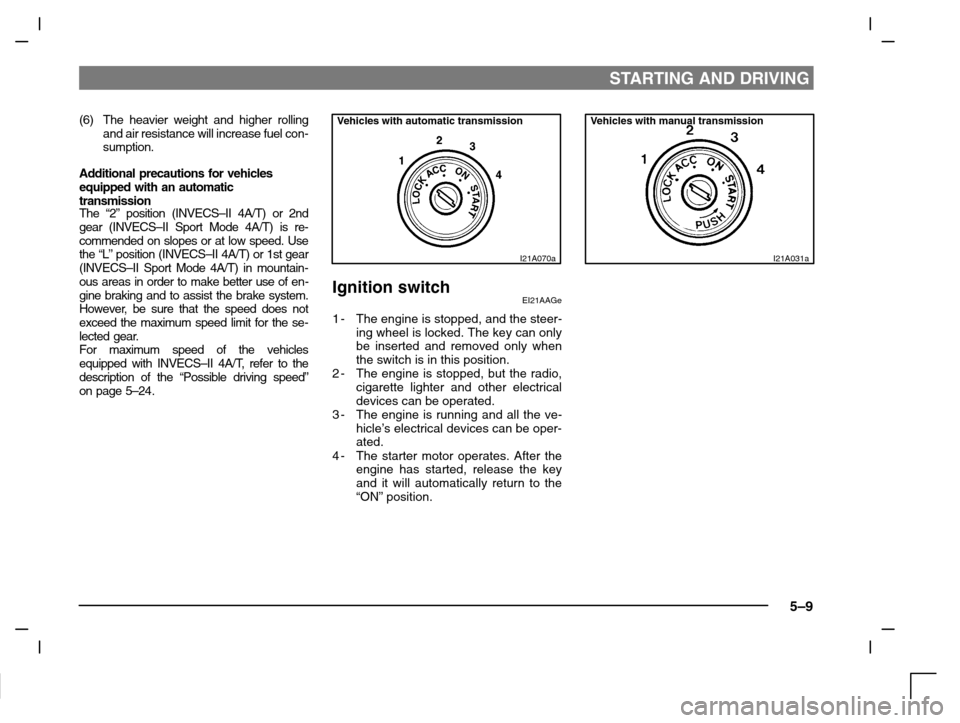
STARTING AND DRIVING
5–9
(6) The heavier weight and higher rolling
and air resistance will increase fuel con-
sumption.
Additional precautions for vehicles
equipped with an automatic
transmission
The “2” position (INVECS–II 4A/T) or 2nd
gear (INVECS–II Sport Mode 4A/T) is re-
commended on slopes or at low speed. Use
the “L” position (INVECS–II 4A/T) or 1st gear
(INVECS–II Sport Mode 4A/T) in mountain-
ous areas in order to make better use of en-
gine braking and to assist the brake system.
However, be sure that the speed does not
exceed the maximum speed limit for the se-
lected gear.
For maximum speed of the vehicles
equipped with INVECS–II 4A/T, refer to the
description of the “Possible driving speed”
on page 5–24.Vehicles with automatic transmission
I21A070a
Ignition switchEI21AAGe
1-The engine is stopped, and the steer-
ing wheel is locked. The key can only
be inserted and removed only when
the switch is in this position.
2-The engine is stopped, but the radio,
cigarette lighter and other electrical
devices can be operated.
3-The engine is running and all the ve-
hicle’s electrical devices can be oper-
ated.
4-The starter motor operates. After the
engine has started, release the key
and it will automatically return to the
“ON” position.
Vehicles with manual transmission
I21A031a
Page 110 of 280
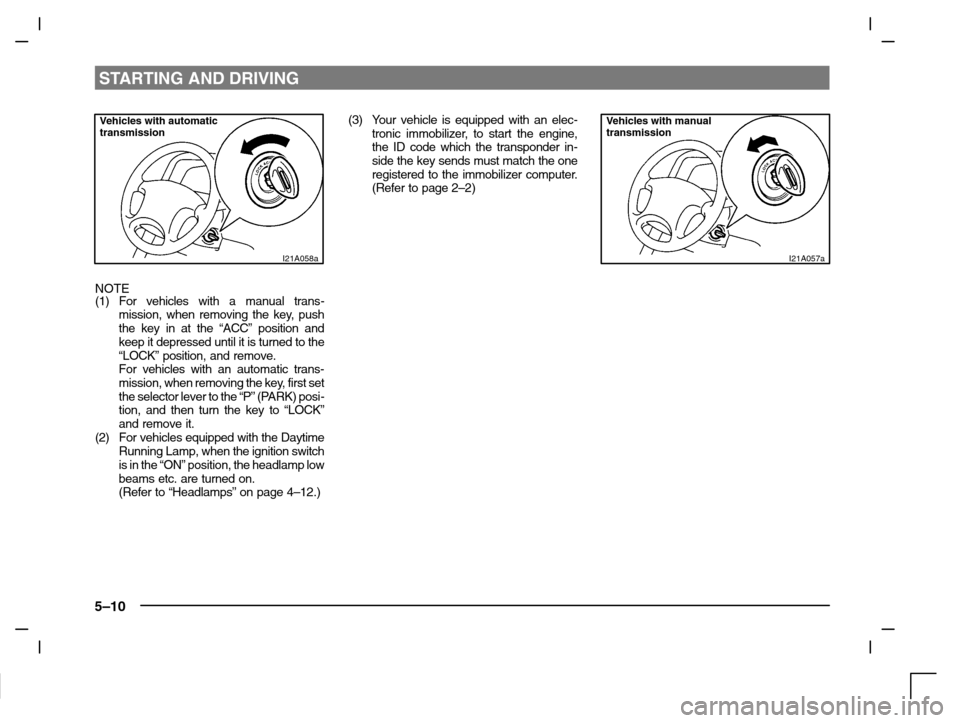
STARTING AND DRIVING
5–10
Vehicles with automatic
transmission
I21A058a
NOTE
(1) For vehicles with a manual trans-
mission, when removing the key, push
the key in at the “ACC” position and
keep it depressed until it is turned to the
“LOCK” position, and remove.
For vehicles with an automatic trans-
mission, when removing the key, first set
the selector lever to the “P” (PARK) posi-
tion, and then turn the key to “LOCK”
and remove it.
(2) For vehicles equipped with the Daytime
Running Lamp, when the ignition switch
is in the “ON” position, the headlamp low
beams etc. are turned on.
(Refer to “Headlamps” on page 4–12.)(3) Your vehicle is equipped with an elec-
tronic immobilizer, to start the engine,
the ID code which the transponder in-
side the key sends must match the one
registered to the immobilizer computer.
(Refer to page 2–2)
Vehicles with manual
transmission
I21A057a